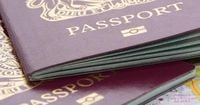British travellers heading to Europe are about to face a new era at the border, with a raft of rule changes and digital systems poised to reshape the familiar experience of entering the Schengen area. From October 12, 2025, the European Union will begin rolling out its much-anticipated Entry-Exit System (EES), a digital border scheme designed to tighten security, enforce visa rules, and streamline crossings for millions of non-EU nationals, including those from the UK, US, Canada, and Australia. But as the new system approaches, recent incidents and official advice underscore just how crucial it is for travellers to be vigilant about documentation—and to understand the fine print that could make or break a long-awaited holiday.
According to The Independent, the EES will connect every external Schengen border—whether at airports, seaports, railway stations, or road crossings—to a central database. The system’s primary goal is to clamp down on crime and enforce the 90-days-in-any-180-days stay limit that now applies to British passport holders post-Brexit, as well as other so-called “third-country nationals.”
Here’s how it works: on a traveller’s first encounter with the EES, they’ll register at a kiosk, placing the photo page of their passport on a scanner and following on-screen instructions. The system will capture their facial image and, for those aged 12 and up, fingerprints, creating a digital record linked to their passport. On subsequent trips, a quick facial scan at a kiosk or eGate will verify their identity against the stored data. The digital record remains valid for three years after each interaction, so regular travellers won’t need to re-register unless they stay away for more than three years. Handily, renewing a passport shouldn’t require starting over, as the system can update records by matching the facial biometric on the new document.
But don’t expect sweeping changes overnight. The EES is being introduced gradually over a 180-day window, from October 12, 2025, to April 9, 2026. Initially, only a small fraction of travellers will use the new system; for example, Germany is starting with Dusseldorf airport. During the first six months, traditional passport stamping and checks will continue alongside the digital process, so most passengers won’t notice much difference—at least at first.
EU passport holders, meanwhile, will breeze through special lanes with a simple glance at their documents, reminiscent of the pre-Brexit days for British travellers. As The Independent puts it, “If you have an EU passport, you can wave us all farewell and be in the bar in record time.”
One question that’s cropped up among British travellers is whether proof of travel insurance will be mandatory under the new system. The UK government has clarified that, while some EES kiosks (notably at London St Pancras International) may ask if you have medical insurance, this is a long-standing French requirement that’s rarely enforced for UK visitors. “Medical insurance will not be a mandatory requirement for UK citizens travelling to the EU under EES,” the Home Office states. Nevertheless, officials “strongly recommend that all passengers purchase comprehensive travel insurance, including medical cover, before travelling abroad.”
Cruise passengers may wonder how the EES affects them. The Home Office has said that sailings starting and ending in the UK are generally exempt from EES checks, even if they include day trips into the Schengen area. However, those embarking or disembarking at a Schengen port—a so-called “fly cruise”—will need to go through the EES at the relevant frontier.
As the rules tighten, the importance of being prepared with the right documents has never been clearer. The UK Foreign Office and travel experts are urging British travellers to carry not just their passport but a second form of photo ID. According to The Mirror, the Foreign Office’s checklist now advises: “Take an extra form of photo ID with you, other than your passport.” Travel expert Seamus McCauley, Head of Public Affairs at Holiday Extras, explains why: “When you’re heading off on holiday, the last thing you want is extra hassle if your passport goes missing. That’s why the Foreign Office suggests packing a second form of photo ID, like your driving licence, along with your passport. If the worst happens, having a spare ID can make it much easier to check into hotels, hire a car or get the help you need from local authorities.”
Kate Staniforth, Head of Marketing at Travel Republic, echoes this advice, adding that a digital backup can be invaluable. “One top tip is to also have a form of photo ID saved on your phone, whether that be a photo of your driving licence or a scan of your Blue Badge saved to your files. It means that if all else fails, you have a digital version you can share in the meantime. However, it’s always important to confirm the identification rules for your destination in advance to ensure a smooth journey and avoid any hiccups whilst there.”
Acceptable forms of backup ID include UK photo card driving licences (full or provisional), biometric residence permits, EEA national identity cards, military ID cards, proof of age cards with a PASS hologram, and various government-issued passes such as the Blue Badge or Freedom Pass. The bottom line? A little preparation goes a long way when it comes to travel documents.
For some, though, the consequences of missing a small but crucial detail can be devastating. That was the case for Chelsea Rodd, a 35-year-old mother from the Isle of Wight, whose holiday plans were derailed by the EU’s updated passport validity rules. As reported by The Daily Mail, Chelsea was set to fly from Gatwick to Milan on September 26, 2025, for a friend’s milestone birthday. Despite her passport being valid until April 2026, it had been issued more than 10 years prior, making it ineligible for EU travel under the 2021 rule requiring passports to be issued within the last 10 years.
Before September 2018, UK passports could include unused months from previous documents, resulting in passports valid for over 10 years. The rule change means the passport’s start date, not just its expiry date, is now critical for EU entry. Chelsea’s attempts to secure an emergency passport failed, and she was forced to miss the trip entirely—a heartbreak she shared in a viral TikTok video, warning others: “I just learned the hard way that for travel to the EU your UK passport must have been issued within the last 10 years.”
Her story struck a chord, with commenters expressing both sympathy and surprise that the rule is still catching people out. Some suggested airlines and booking systems should do more to flag the requirement, while others insisted it’s “common knowledge” and ultimately the traveller’s responsibility. EasyJet, the airline involved, stated: “We remind customers during booking, check-in and by email before they travel to ensure they are aware of the travel documentation requirements for their trip, and it is customers’ responsibility to ensure they have valid documentation for travel.”
As the EES begins its phased introduction and passport rules continue to trip up even seasoned travellers, the message is clear: double-check your documents, read the fine print, and don’t leave preparation to chance. A little extra vigilance now could be the difference between a dream holiday and a tearful journey home.





